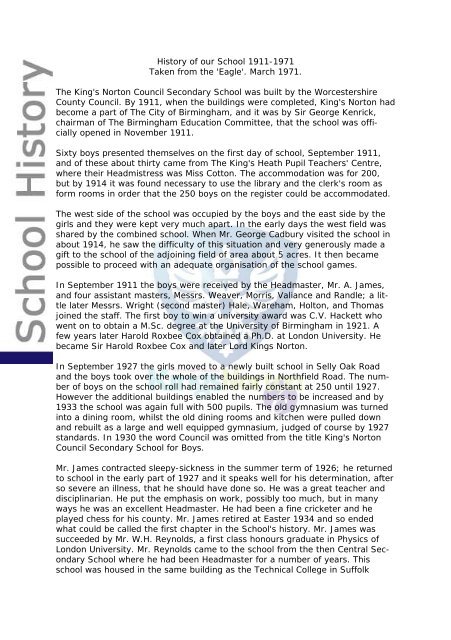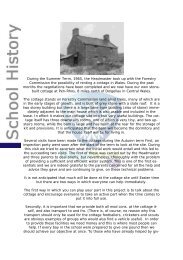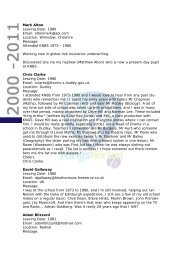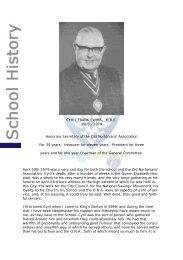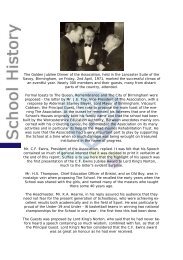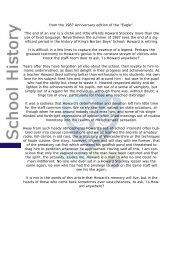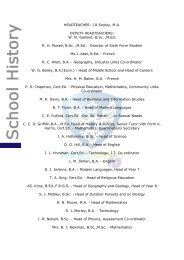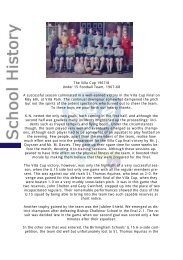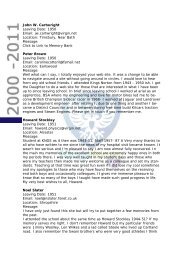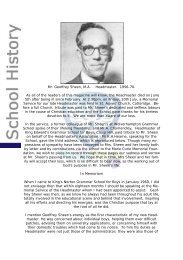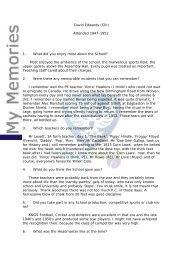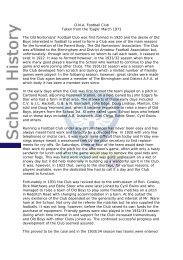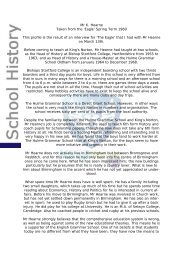The history of our School - Kings Norton Boys
The history of our School - Kings Norton Boys
The history of our School - Kings Norton Boys
You also want an ePaper? Increase the reach of your titles
YUMPU automatically turns print PDFs into web optimized ePapers that Google loves.
History <strong>of</strong> <strong>our</strong> <strong>School</strong> 1911-1971<br />
Taken from the 'Eagle'. March 1971.<br />
<strong>The</strong> King's <strong>Norton</strong> Council Secondary <strong>School</strong> was built by the Worcestershire<br />
County Council. By 1911, when the buildings were completed, King's <strong>Norton</strong> had<br />
become a part <strong>of</strong> <strong>The</strong> City <strong>of</strong> Birmingham, and it was by Sir George Kenrick,<br />
chairman <strong>of</strong> <strong>The</strong> Birmingham Education Committee, that the school was <strong>of</strong>ficially<br />
opened in November 1911.<br />
Sixty boys presented themselves on the first day <strong>of</strong> school, September 1911,<br />
and <strong>of</strong> these about thirty came from <strong>The</strong> King's Heath Pupil Teachers' Centre,<br />
where their Headmistress was Miss Cotton. <strong>The</strong> accommodation was for 200,<br />
but by 1914 it was found necessary to use the library and the clerk's room as<br />
form rooms in order that the 250 boys on the register could be accommodated.<br />
<strong>The</strong> west side <strong>of</strong> the school was occupied by the boys and the east side by the<br />
girls and they were kept very much apart. In the early days the west field was<br />
shared by the combined school. When Mr. George Cadbury visited the school in<br />
about 1914, he saw the difficulty <strong>of</strong> this situation and very generously made a<br />
gift to the school <strong>of</strong> the adjoining field <strong>of</strong> area about 5 acres. It then became<br />
possible to proceed with an adequate organisation <strong>of</strong> the school games.<br />
In September 1911 the boys were received by the Headmaster, Mr. A. James,<br />
and f<strong>our</strong> assistant masters, Messrs. Weaver, Morris, Valiance and Randle; a little<br />
later Messrs. Wright (second master) Hale, Wareham, Holton, and Thomas<br />
joined the staff. <strong>The</strong> first boy to win a university award was C.V. Hackett who<br />
went on to obtain a M.Sc. degree at the University <strong>of</strong> Birmingham in 1921. A<br />
few years later Harold Roxbee Cox obtained a Ph.D. at London University. He<br />
became Sir Harold Roxbee Cox and later Lord <strong>Kings</strong> <strong>Norton</strong>.<br />
In September 1927 the girls moved to a newly built school in Selly Oak Road<br />
and the boys took over the whole <strong>of</strong> the buildings in Northfield Road. <strong>The</strong> number<br />
<strong>of</strong> boys on the school roll had remained fairly constant at 250 until 1927.<br />
However the additional buildings enabled the numbers to be increased and by<br />
1933 the school was again full with 500 pupils. <strong>The</strong> old gymnasium was turned<br />
into a dining room, whilst the old dining rooms and kitchen were pulled down<br />
and rebuilt as a large and well equipped gymnasium, judged <strong>of</strong> c<strong>our</strong>se by 1927<br />
standards. In 1930 the word Council was omitted from the title King's <strong>Norton</strong><br />
Council Secondary <strong>School</strong> for <strong>Boys</strong>.<br />
Mr. James contracted sleepy-sickness in the summer term <strong>of</strong> 1926; he returned<br />
to school in the early part <strong>of</strong> 1927 and it speaks well for his determination, after<br />
so severe an illness, that he should have done so. He was a great teacher and<br />
disciplinarian. He put the emphasis on work, possibly too much, but in many<br />
ways he was an excellent Headmaster. He had been a fine cricketer and he<br />
played chess for his county. Mr. James retired at Easter 1934 and so ended<br />
what could be called the first chapter in the <strong>School</strong>'s <strong>history</strong>. Mr. James was<br />
succeeded by Mr. W.H. Reynolds, a first class hon<strong>our</strong>s graduate in Physics <strong>of</strong><br />
London University. Mr. Reynolds came to the school from the then Central Secondary<br />
<strong>School</strong> where he had been Headmaster for a number <strong>of</strong> years. This<br />
school was housed in the same building as the Technical College in Suffolk
Street and conditions were very difficult. <strong>The</strong> new headmaster was pleased to<br />
be in a school where the buildings actually belonged to the school.<br />
Mr. Reynolds introduced many new ideas. <strong>The</strong> first was the introduction <strong>of</strong> the<br />
prefect system <strong>of</strong> which he wrote in a subsequent issue <strong>of</strong> the school magazine,<br />
they have carried out their new duties with ability and discretion, and their assistance<br />
is appreciated by the staff. <strong>The</strong> second notable innovation, at that time,<br />
was the organisation <strong>of</strong> the school into houses. <strong>The</strong>se, Greves, Jervoise, Lyttleton,<br />
Middlemore and Mortimer were named after distinguished families who<br />
had, during the years, developed strong connection with King's <strong>Norton</strong> and<br />
Northfield. <strong>The</strong>se names have come to mean much to old boys <strong>of</strong> the school.<br />
Many societies were formed. Mr. T. Welburn and Mr. Ecclestone inaugurated the<br />
Scientific Society and it is pleasing to note that this has continued with success<br />
until the present time. <strong>The</strong> dramatic society was formed on a much larger scale;<br />
a cyclorama was built into the back <strong>of</strong> the stage and an efficient switch board<br />
and lighting system were installed by members <strong>of</strong> the staff and boys. <strong>The</strong> plays<br />
presented for the first public performance were Tom Thumb <strong>The</strong> Great and Under<br />
the Skull and Bones produced by Mr. Roach and Mr. Cole respectively. <strong>The</strong><br />
plays were very successful and were the forerunners <strong>of</strong> many others, such as<br />
Androcles and <strong>The</strong> Lion, Man and Superman, <strong>The</strong> Rising Generation, She Stoops<br />
to Conquer and <strong>The</strong> Admirable Crichton. Other new societies included the Model<br />
Railway Club, <strong>The</strong> Hobbies Club, <strong>The</strong> Lecture and Debating Society, <strong>The</strong> Natural<br />
History Society, <strong>The</strong> Chess Club, <strong>The</strong> Wireless Club and the Bee Keeping Society.<br />
A Parent-Teacher Association was formed in 1935 and in 1936 a Jubilee Pavilion<br />
was built on the school field; the cost <strong>of</strong> this was borne jointly by the Education<br />
Committee and the <strong>School</strong>. <strong>The</strong> first commemoration service was held at St.<br />
Nicolas Church, King's <strong>Norton</strong> for the celebration by the school <strong>of</strong> its 25th anniversary.<br />
<strong>The</strong> service was conducted by Canon T.S. Dunn, vicar <strong>of</strong> King's <strong>Norton</strong>,<br />
and the address was given by the Ven. J.H. Richards, Archdeacon <strong>of</strong> Aston. This<br />
service became an annual one.<br />
In August 1935, the first overseas holiday in the <strong>history</strong> <strong>of</strong> the school was organised<br />
. F<strong>our</strong> masters accompanied 72 boys to Norway, Sweden, Denmark,<br />
Finland and Germany. <strong>The</strong> party sailed in the troop-ship Neuralia and the cruise<br />
was sponsored by <strong>The</strong> Secondary <strong>School</strong>s' Travel Trust. It is interesting to reflect<br />
that the total cost including excursions and foreign currency was about £8.<br />
10. 0d. per head.<br />
In July, 1935, the school obtained its first state scholarship through R.W. Stanford<br />
who subsequently went to Christ's College, Cambridge. At Easter 1939, the<br />
school became King's <strong>Norton</strong> Grammar <strong>School</strong> for <strong>Boys</strong> Later in the same year<br />
war was declared on Germany and so ended another phase in the school's <strong>history</strong>.<br />
Many staff and boys will always remember Friday, 1st September 1939, the day<br />
that the school was evacuated to Gloucester. As a short magazine report so well<br />
expressed it at the time - <strong>The</strong> pelting rain <strong>of</strong> the morning; the hot sunshine <strong>of</strong><br />
the afternoon; the foreboding tin hats <strong>of</strong> the King's <strong>Norton</strong> A.R.P. <strong>of</strong>ficials; the
mellow serenity <strong>of</strong> Evesham's apple orchards; Birmingham's indifference to <strong>our</strong><br />
departure; Gloucester's staring multitudes. We were not made particularly welcome<br />
by the Crypt <strong>School</strong> but all made the best <strong>of</strong> it. Many will recall the spectacle<br />
<strong>of</strong> the Severn Bore, the school's invasion <strong>of</strong> <strong>The</strong> Plaza Cinema where the<br />
film <strong>The</strong> Mikado was shown, <strong>our</strong> lessons in the afternoons only, the commemoration<br />
service held at Gloucester Cathedral, <strong>our</strong> visits to Painswick Beacon and<br />
so on. However the evacuation was short-lived; the school returned to Birmingham<br />
in March 1940 in time for the bombing which occurred later.<br />
During 1940 lessons were interrupted from time to time by air raid warnings<br />
and an orderly procession moved to the air raid shelters which had been<br />
erected. In April a National Savings Group was formed; by 1945 this had<br />
reached the splendid total <strong>of</strong> £13,111. During December <strong>The</strong> Pig and Poultry<br />
Club came into being. Pigs were fed and slaughtered at the appropriate time.<br />
Some <strong>of</strong> the pork was distributed to the shareholders in lieu <strong>of</strong> dividend whilst<br />
the rest was sold to <strong>The</strong> Meat Control Board.<br />
In April 1941, the King's <strong>Norton</strong> and B<strong>our</strong>neville Squadron <strong>of</strong> the Air Training<br />
Corps were inaugurated under the command <strong>of</strong> Flt. Lt. W.H. Reynolds M.C., the<br />
<strong>of</strong>ficers including F.O. L.K. Ecclestone, P/O S.E. Pickering and F/O D.W.<br />
Wheeler. <strong>The</strong> extremely efficient warrant <strong>of</strong>ficer was Mr. Frank Waltew, the chief<br />
grounds man <strong>of</strong> the Birmingham Education Committee. <strong>The</strong> school was the<br />
headquarters and much <strong>of</strong> the work normally carried out at Initial Training<br />
Wings was now done by the A.T.C. A very high standard was reached by the<br />
240 cadets and many will recall the winning <strong>of</strong> the Wing Cup, Church Parades,<br />
camps at Tern Hill and Hereford and many other occasions. In May 1942, an<br />
Army Cadet Force was formed under the direction <strong>of</strong> the local battalion <strong>of</strong> <strong>The</strong><br />
Home Guard.<br />
From July 1942 and continuing for about f<strong>our</strong> years, successful Harvest Camps<br />
were held at Offchurch, Near Leamington. <strong>The</strong> local cricket pavilion provided the<br />
headquarters and tents were erected on the field. Much <strong>of</strong> the organisation was<br />
arranged by <strong>The</strong> Warwickshire War Agricultural Committee, ably assisted by the<br />
late Mr. Brian Hindle.<br />
After the war, life gradually returned to normal. Functions were again held at<br />
the school and societies were reformed. Prefabricated classrooms were erected<br />
in the east playground in about 1946 and they were <strong>of</strong> great help although their<br />
heating was always a s<strong>our</strong>ce <strong>of</strong> trouble. <strong>The</strong> late Mr. R.T. Cooling was elected a<br />
judge at the 14th Olympic held in 1948 at the White City; this was a great<br />
honor for the school. Mr. K.R. Welburn designed the War Memorial to old boys<br />
who had given their lives in the first and second world wars. This was dedicated<br />
by the Ven. G.C. St. M. Parker, the Archdeacon <strong>of</strong> Aston, on Sunday 24th April<br />
1949 and was unveiled by Mr. F.W. Wright, the second master <strong>of</strong> the school,<br />
who was at the time the president <strong>of</strong> the Old <strong>Norton</strong>ians Association and who<br />
had done so much to keep the Association together during the war years.<br />
In August 1949, the school began a series <strong>of</strong> holiday camps at the Isle <strong>of</strong> Wight.<br />
<strong>The</strong>se were held at St. Helens, between Bembridge and Sea View, where an excellent<br />
site was shared with Queen Elizabeth Hospital, Bristol. Many old boys will<br />
remember with pleasure Messrs. Richardson and Brooks from Bristol, <strong>The</strong> glori-
ous bathing and the many incidents which made <strong>our</strong> holidays there so delightful.<br />
In December 1949, Mr. F.W. Wright retired and was succeeded as Deputy<br />
Headmaster by Mr. L.K. Ecclestone.<br />
In January 1952, Mr. Reynolds, the Headmaster was awarded the O.B.E. He<br />
himself insisted that this was an hon<strong>our</strong> , not for himself, but for the school.<br />
However in addition to his arduous duties as a headmaster, he was a devoted<br />
educationist and had done much for the teaching <strong>of</strong> general science. He was a<br />
member <strong>of</strong> the Joint Matriculation Board and chairman <strong>of</strong> the King's <strong>Norton</strong><br />
Branch <strong>of</strong> the United Nations Association. He was a member <strong>of</strong> the committee<br />
and a past chairman <strong>of</strong> the City <strong>of</strong> Birmingham choir and a governor <strong>of</strong> Saltley<br />
Training College. He thus richly deserved this great honor in his own right.<br />
At Easter 1953, many new building changes took place at the school, changes<br />
which Mr. Reynolds had asked for when he first came to the school in 1934.<br />
New cycle accommodation on the east field.<br />
<strong>The</strong> Art block was built.<br />
<strong>The</strong> General Chemistry Laboratory and General Biology Laboratory were built.<br />
<strong>The</strong> old art room was converted into a library.<br />
<strong>The</strong> old library was converted into an <strong>of</strong>fice.<br />
<strong>The</strong> old <strong>of</strong>fice became the second master's room.<br />
In 1954 the school acquired a motto which had hitherto been lacking:<br />
Humani semper contendimus.<br />
We, being c<strong>our</strong>teous, sympathetic and understanding,constantly strive.<br />
<strong>The</strong> number <strong>of</strong> boys on the school roll was about 700 when in August 1956. Mr.<br />
Reynolds retired. So ended the second chapter in the school's <strong>history</strong>. Mr. W.H.<br />
Reynolds was succeeded by Mr. G. Sheen. Mr. Sheen was an open scholar <strong>of</strong><br />
Corpus Christi College, Oxford, where he gained first class hon<strong>our</strong>s in Mathematical<br />
Moderations and in the Final Hon<strong>our</strong>s <strong>School</strong> <strong>of</strong> Mathematics - with distinction<br />
in atomic structure. He had been senior mathematics master at Wolverhampton<br />
Grammar <strong>School</strong> and head <strong>of</strong> the mathematics and science departments<br />
at Bromsgrove <strong>School</strong>. He had been a very active scout leader and he<br />
had strong interests in music, school orchestras and dramatic societies. He was<br />
an active member <strong>of</strong> the<br />
congregational Church and he had a growing interest in philosophy. Above all<br />
he was a most able and enthusiastic educationist with a tremendous capacity<br />
for work.<br />
Mr. Sheen's task was a very difficult one at the time <strong>of</strong> his appointment since<br />
the number <strong>of</strong> boys in the school was steadily growing each year. In the early
1960's, the peak was reached when the number was 780 and conditions became<br />
most difficult; 100 boys were entered for A level. <strong>The</strong> acquisition <strong>of</strong> Brunnaker<br />
House was a great help but not altogether suitable, However progress<br />
continued to be made, a fate was organised by the Parent-Teacher Association<br />
as a result <strong>of</strong> which the school obtained its own electronic organ. Later an excellent<br />
gymnasium was built, the old gymnasium became a new dining room and<br />
arrangements were much improved. Through the efforts <strong>of</strong> Mr. Sheen, the<br />
school forged a link with Solesi through the person <strong>of</strong> Neil Nkanza, boys have<br />
taken part in American Field Service and in Voluntary Service overseas.<br />
<strong>The</strong> Parent-Teacher Association also provided a sailing boat for the school and<br />
sailing took place on the Earlswood lakes. A little later Alderman Ernest Tye,<br />
J.P., who was then Mayor <strong>of</strong> St<strong>our</strong>bridge, kindly presented the school with another<br />
boat.<br />
In 1966 Mr. Sheen acquired for the school a cottage at Pen-Rhos in Merionethshire<br />
on a 50 years lease from <strong>The</strong> Forestry Commission. This is now the venue<br />
for many happy and instructional visits. In 1967 the old prefabricated class<br />
rooms were removed and a splendid sixth form block, including a new staff<br />
room, was built. <strong>The</strong> base <strong>of</strong> this block is now the music room.<br />
During the last 60's- early 70's the school excelled at games, particularly association<br />
football and basketball. <strong>The</strong> dramatic society, too, staged productions <strong>of</strong><br />
outstanding merit whilst overseas visits costing upwards <strong>of</strong> £50 were commonplace.<br />
Mr. L.K. Ecclestone, <strong>The</strong> Deputy Headmaster, retired in July, 1968 and<br />
was succeeded by Mr. K.A. Hearne who came to us from <strong>The</strong> Hulme Grammar<br />
<strong>School</strong>, Oldham. In September 1969, it was found necessary to reduce the<br />
number <strong>of</strong> houses from five to f<strong>our</strong>; many old boys will feel a tinge <strong>of</strong> regret at<br />
the passing <strong>of</strong> Greves. Jervoise, Lyttleton, Middlemore and Mortimer in spite <strong>of</strong><br />
the fact that they have been replaced by such distinguished names as James.<br />
Reynolds. Weaver and Wright.<br />
It was with deep regret that we learned <strong>of</strong> the tragic death <strong>of</strong> <strong>our</strong> Headmaster,<br />
Mr. G. Sheen on 5th June 1970. An appreciation <strong>of</strong> Mr. Sheen's great work,<br />
written by Mr. K.A. Hearne, is printed in <strong>The</strong> Autumn 1970 edition <strong>of</strong> <strong>The</strong> Eagle.<br />
Mr. Hearne had been beset with illness and great difficulties since he became<br />
Deputy Headmaster in January 1969. Everyone was delighted when be was appointed<br />
to succeed Mr. Sheen as Headmaster <strong>of</strong> the <strong>School</strong> in October 1970.<br />
What lies ahead From July 1966 onwards, Sir Lionel Russell produced numerous<br />
schemes for the education <strong>of</strong> Birmingham children. However, education<br />
and politics are closely linked and other schemes had to be formulated. It now<br />
seems likely that the <strong>School</strong> will maintain its Grammar <strong>School</strong> status for some<br />
time. If one day, comprehensive education for all is to come, it is hoped that it<br />
will be administered in purpose-built <strong>School</strong>s.<br />
Come what may, the old Grammar <strong>School</strong> in King's <strong>Norton</strong> Church Yard will always<br />
be a reminder <strong>of</strong> <strong>our</strong> own grammar school although <strong>our</strong> connection with it<br />
is one <strong>of</strong> name only. <strong>The</strong> date <strong>of</strong> origin <strong>of</strong> this old school is still a matter <strong>of</strong><br />
speculation, but it is probably 1344, when Edward III signed letters patent, licensing<br />
William Pass, vicar <strong>of</strong> King's <strong>Norton</strong>, to build a house on the church
grounds. It seems that its educational function was intended from the beginning,<br />
and it was established as a full grammar school <strong>of</strong> some note in the sixteenth<br />
century, fulfilling this role until 1884. <strong>The</strong> building, now scheduled as an<br />
ancient monument, was restored in 1951 and houses a collection <strong>of</strong> books,<br />
maps, furniture and other items <strong>of</strong> local interest.<br />
In looking to the future <strong>our</strong> destinies are, we know, in the hands <strong>of</strong> others, not<br />
<strong>our</strong>selves. On behalf <strong>of</strong> all who have passed through <strong>our</strong> school and all who<br />
have a genuine affection for it, one hope that those who have it in their power<br />
to shape <strong>our</strong> ends will remember that there has been a King's <strong>Norton</strong> Grammar<br />
<strong>School</strong> since the 14th century.<br />
Surely this is a tradition that should not be readily forsaken.<br />
L.K. Ecclestone.


